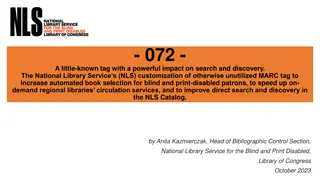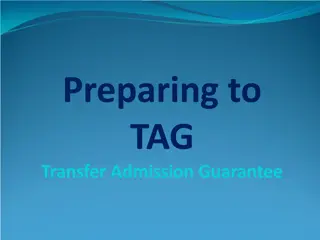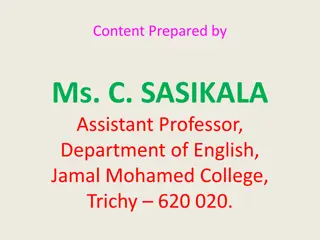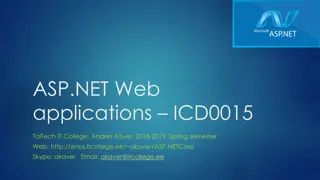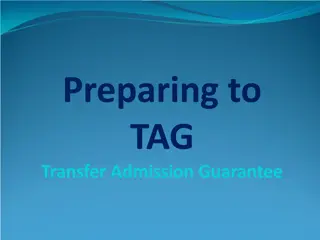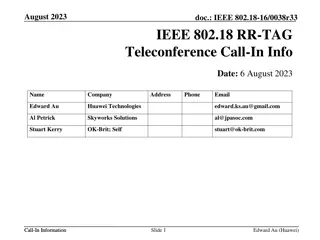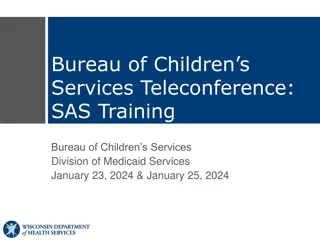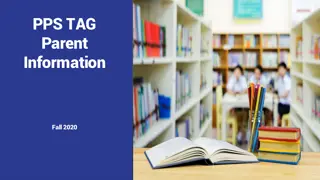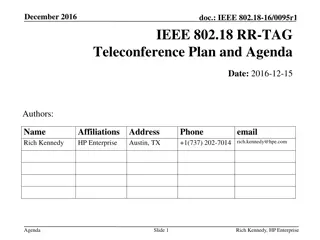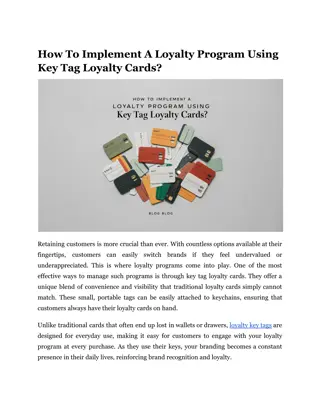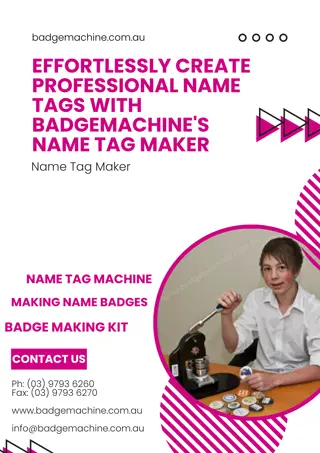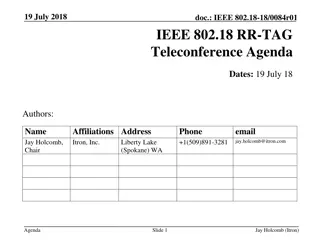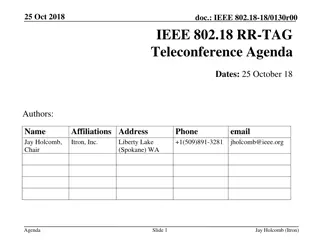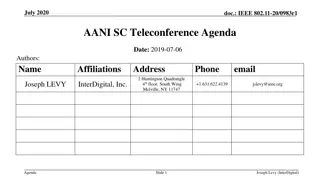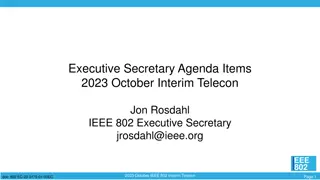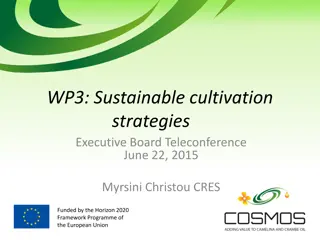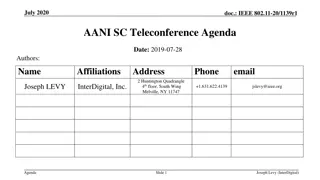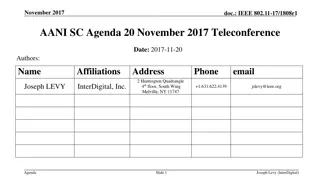
IEEE 802.18-18/0064r01 Teleconference Agenda
This document outlines the agenda for the IEEE 802.18-18/0064r01 teleconference chaired by Jay Holcomb, covering administrative items, guidelines for IEEE WG meetings, and participation in IEEE 802 meetings. It emphasizes compliance with antitrust laws, patent discussions, and individual participation in consensus processes.
Download Presentation

Please find below an Image/Link to download the presentation.
The content on the website is provided AS IS for your information and personal use only. It may not be sold, licensed, or shared on other websites without obtaining consent from the author. If you encounter any issues during the download, it is possible that the publisher has removed the file from their server.
You are allowed to download the files provided on this website for personal or commercial use, subject to the condition that they are used lawfully. All files are the property of their respective owners.
The content on the website is provided AS IS for your information and personal use only. It may not be sold, licensed, or shared on other websites without obtaining consent from the author.
E N D
Presentation Transcript
07 June 2018 doc.: IEEE 802.18-18/0064r01 IEEE 802.18 RR-TAG Teleconference Agenda Dates: 07 June 18 Authors: Name Jay Holcomb, Chair Affiliations Address Itron, Inc. Phone +1(509)891-3281 email jay.holcomb@itron.com Liberty Lake (Spokane) WA Agenda Slide 1 Jay Holcomb (Itron)
07 June 2018 doc.: IEEE 802.18-18/0064r01 Call to Order / Administrative Items Number of voters: 41 (8 on EC); Nearly voters: 1; Aspirant members: 9 With teleconferences approval on 08 March 2018, quorum is met. Required notices Affiliation FAQ - http://standards.ieee.org/faqs/affiliationFAQ.html > Be sure to announce you name, affiliation, employer and clients the first time you speak. Anti-Trust FAQ - http://standards.ieee.org/resources/antitrust-guidelines.pdf Ethics - https://www.ieee.org/about/corporate/governance/p7-8.html IEEE 802 WG Policies and Procedures - http://www.ieee802.org/devdocs.shtml The 4 administration slides, reminder from your WG opening plenary new 02jan18 (note: call for essential patents is n/a, as the RR-TAG does not do standards) Officers or the RR-TAG / IEEE 802.18: Chair is Jay Holcomb (Itron) Vice-chair is open Secretary is Allan Zhu (Huawei) Agenda Slide 2 Jay Holcomb (Itron)
07 June 2018 doc.: IEEE 802.18-18/0064r01 Other Guidelines for IEEE WG Meetings All IEEE-SA standards meetings shall be conducted in compliance with all applicable laws, including antitrust and competition laws. Don t discuss the interpretation, validity, or essentiality of patents/patent claims. Don t discuss specific license rates, terms, or conditions. Relative costs of different technical approaches that include relative costs of patent licensing terms may be discussed in standards development meetings. Technical considerations remain the primary focus Don t discuss or engage in the fixing of product prices, allocation of customers, or division of sales markets. Don t discuss the status or substance of ongoing or threatened litigation. Don t be silent if inappropriate topics are discussed do formally object. --------------------------------------------------------------- For more details, see IEEE-SA Standards Board Operations Manual, clause 5.3.10 and Antitrust and Competition Policy: What You Need to Know at http://standards.ieee.org/develop/policies/antitrust.pdf Agenda Slide 3 Jay Holcomb (Itron)
07 June 2018 doc.: IEEE 802.18-18/0064r01 Participation in IEEE 802 Meetings Participation in any IEEE 802 meeting (Sponsor, Sponsor subgroup, Working Group, Working Group subgroup, etc.) is on an individual basis Participants in the IEEE standards development individual process shall act based on their qualifications and experience. (https://standards.ieee.org/develop/policies/bylaws/sb_bylaws.pdf section 5.2.1) IEEE 802 Working Group membership is by individual; Working Group members shall participate in the consensus process in a manner consistent with their professional expert opinion as individuals, and not as organizational representatives . (subclause 4.2.1 Establishment , of the IEEE 802 LMSC Working Group Policies and Procedures) Participants have an obligation to act and vote as an individual and not under the direction of any other individual or group. A Participant s obligation to act and vote as an individual applies in all cases, regardless of any external commitments, agreements, contracts, or orders. Participants shall not direct the actions or votes of any other member of an IEEE 802 Working Group or retaliate against any other member for their actions or votes within IEEE 802 Working Group meetings, see https://standards.ieee.org/develop/policies/bylaws/sb_bylaws.pdf section 5.2.1.3 and the IEEE 802 LMSC Working Group Policies and Procedures, subclause 3.4.1 Chair , list item x. By participating in IEEE 802 meetings, you accept these requirements. If you do not agree to these policies then you shall not participate. (and please leave the call.) Slide 4 Agenda Jay Holcomb (Itron)
07 June 2018 doc.: IEEE 802.18-18/0064r01 Agenda Call to Order Discussion items, few more details: Attendance server is open Administrative items EU Items, what is the latest from members. Anything we should respond to? Need a recording secretary Approve agenda & last minutes Any interest in being the 802.18 Vice-Chair? A Future for Unlicensed Spectrum What can we do to help regulators to open up more unlicensed spectrum. Discussion items EU Items A Future for Unlicensed Spectrum Fellowship assistance NTIA, improve broadband availability data FCC Open Meeting, FNPRM Above 24 GHz NPRM 2.5 GHz Fellowship technical assistance. Satellite Communication (e.g: C band in IEEE, etc.) 5G readiness and implementation NTIA, improve broadband availability data requesting comment on actions that can be taken to improve the quality and accuracy, by 16 July. FCC Open Meeting, p/o Spectrum Frontiers Third Report and Order, Memorandum Opinion and Order, and Third Further Notice of Proposed Rulemaking above 24GHz Actions required What happens during the call AOB and Adjourn NPRM 2.5 GHz, any interest? providing new opportunities for additional entities to obtain unused 2.5 GHz spectrum (seems licensed ) Comments due 06 Aug 2018 Agenda Agenda Slide 5 Jay Holcomb (Itron)
07 June 2018 doc.: IEEE 802.18-18/0064r01 Motions - administrative Motion: To approve the agenda as presented on previous slide Moved by: Stuart Kerry (Arris/Ruckus) Seconded by: Rich Kennedy (Self) Discussion? Vote: Unanimous consent Motion: To approve minutes from the IEEE 802.18 teleconference on 17 May 2018; https://mentor.ieee.org/802.18/dcn/18/18-18-0062-00-0000-minutes-31may18-rr- tag-teleconference.doc; Posted: 01-Jun-2018 10:20:02 ET Moved by: Rich Kennedy (Self) Seconded by: Alireza Nejatian (Ericsson AB) Discussion? Vote: Unanimous consent Agenda Slide 6 Jay Holcomb (Itron)
07 June 2018 doc.: IEEE 802.18-18/0064r01 EU items Anything to share on the EU front? SE45: Emails are looking tough for the 6 GHz band from satellite folks and others. Are there any better sites/links to monitor for EU news? Just the basics: ETIS - BRAN and ERM (TG-11) CEPT - ECC OJEU itself. ITU(SPbU) seminar for CIS and Europe https://www.itu.int/en/ITU-R/study-groups/workshops/DMRE-CIS- Europe/Pages/default.aspx Development of the modern radiocommunication ecosystems 6-8 June 2018, St. Petersburg Main idea of seminar- to discuss future vision of radiocommunication development in main industries concerned (current status, general trends, economics, standardization, frequency issues). Will ask for minutes / outcome of the seminar, in particular with RLANs in mind. (has program/agenda and presentations) Agenda Slide 7 Jay Holcomb (Itron)
07 June 2018 doc.: IEEE 802.18-18/0064r01 A Future For Unlicensed Spectrum from last week A perspective on regardless of everything we do to develop new, better, faster wireless technologies, the available spectrum has a hard limit See: https://mentor.ieee.org/802.18/dcn/18/18-18-0060-02-0000-a-future- for-unlicensed-spectrum.pptx Will review and discuss The idea is to cover the entire spectrum in the database, all of it. Then knowing what frequency range the device is in and geographic location, can manage the users. Similar idea years back were not fully accepted, though with recent actions, e.g. 6GHz, a data base maybe viewed differently now. Should look at the CBRS database and what can we learn from it. This is a long term effort, and need to start to put all the pieces together, before going to regulators. 3550 filings of interest: Google October 2017 overall summary https://ecfsapi.fcc.gov/file/10160477327041/2017-10-16%20Ex%20Parte%20(GN%2012-354%20RM-11788%20RM- 11789).pdf Slide 16 SAS providers & carriers have developed a mutuall satisfactory legal agreement covering confidential data Appendix A:Wireless Innovation Forum and SAS and CBSD Standards Development https://ecfsapi.fcc.gov/file/60001854348.pdf Agenda Slide 8 Jay Holcomb (Itron)
07 June 2018 doc.: IEEE 802.18-18/0064r01 A Future For Unlicensed Spectrum-2 A perspective on regardless of everything we do to develop new, better, faster wireless technologies, the available spectrum has a hard limit A presentation is being prepared for IEEE 802.11 WNG at the plenary in San Diego in July. https://mentor.ieee.org/802.11/dcn/18/11-18-1055-00-0wng-a-future-for- unlicensed-spectrum.pptx This presentation is more standards based, where the 802.18 version was more regulatory based. Agenda Slide 9 Jay Holcomb (Itron)
07 June 2018 doc.: IEEE 802.18-18/0064r01 Fellowship Technical Assistance IEEE 802 received a request for Technical Assistance from a regulatory from the March Fellowship program, on topics below: Who can help on these? Where could there be more info for the request? do we need further clarity? Have her join one of our calls? (time zones?) Satellite Communication (e.g.: C band in IEEE, etc.) Not an IEEE 802 topic. Will find where in IEEE there is satellite activities. Will look for the society that covers this. It maybe outside the SA, and should check in the technical activities. 5G readiness and implementation Same as above, though more 5G is at the SA level. Could check with the 802.11 ANNI chair. At the SA level should check with the co-chairs of the Beyond 5G activity, Ashutosh Dutta and Gerhard Fettweis. https://5g.ieee.org/ Agenda Slide 10 Jay Holcomb (Itron)
07 June 2018 doc.: IEEE 802.18-18/0064r01 NTIA, improve broadband availability data The National Telecommunications and Information Administration (NTIA), on behalf of the Department of Commerce (Department), is requesting comment on actions that can be taken to improve the quality and accuracy of broadband availability data, particularly in rural areas, as part of the activities directed by Congress in the Consolidated Appropriations Act of 2018. https://mentor.ieee.org/802.18/dcn/18/18-18-0063-00-0000-ntia-improving-quality- accuracy-of-broadband-data-usage.docx Comments due 16 July 2018 Presently, the only source of nationwide broadband availability data is that collected from broadband service provider responses to the FCC Form 477 Fixed Broadband Deployment data process. https://www.fcc.gov/general/broadband-deployment-data-fcc-form-477 Do we have any interest? Would it be helpful for standards development? Not looking like it. If the data has contours we could look further, but doubt it has contours. Agenda Slide 11 Jay Holcomb (Itron)
07 June 2018 doc.: IEEE 802.18-18/0064r01 FCC Open Meeting Today https://www.federalregister.gov/documents/2018/06/07/2018-12184/open-commission- meeting-thursday-june-7- 2018?utm_campaign=subscription%20mailing%20list&utm_source=federalregister.gov& utm_medium=email ECFS: https://www.fcc.gov/ecfs/search/filings?proceedings_name=14-177&sort=date_disseminated,DESC Mentor - FNPRM: https://mentor.ieee.org/802.18/dcn/18/18-18-0065-00-0000-fcc-3rd-ro-3rd-fnprm-use-above-24-ghz- gn-14-177.pdf IEEE 802 comments to the NOI in 2014: https://mentor.ieee.org/802.18/dcn/14/18-14-0073-03-0000-comments-to-fcc- noi-on-above-24-ghz-gn-14-177.docx Summary: The Commission will consider a Third Report and Order, Memorandum Opinion and Order, and Third Further Notice of Proposed Rulemaking that would continue efforts to make available millimeter wave spectrum, in bands at or above 24 GHz, for fifth-generation wireless, Internet of Things, and other advanced spectrum-based services. It would finalize rules for certain of these bands and seek comment on making additional spectrum available in the 26 GHz and 42 GHz bands for flexible terrestrial wireless use, sharing mechanisms in the Lower 37 GHz band, and earth station siting criteria for the 50 GHz band. Comments due: 10 Sep 2018; Reply Comments: 28 Sep 2018 Initial quick run though, not seeing anything on 60 GHz. Agenda Slide 12 Jay Holcomb (Itron)
31 May 2018 doc.: IEEE 802.18-18/0064r01 FCC NPRM 2.5 GHz -1 Amendment of Parts 1, 21, 73, 74 and 101 of the Commission s Rules to Facilitate the Provision of Fixed and Mobile Broadband Access, Educational and Other Advanced Services in the 2150-2162 and 2500-2690 MHz Bands (WT 03-66, terminated) Transforming the 2.5 GHz Band (WTB 18-120) Comments due: 30 days; Reply comments due: 60 days https://www.fcc.gov/ecfs/filing/0510125420096 https://www.fcc.gov/ecfs/search/filings?proceedings_name=18-120&sort=date_disseminated,DESC Any interest? No one has expressed any interest to comment, had moved to the backup slides for now. Though just now, been posted in the Federal Register with dates. https://www.federalregister.gov/documents/2018/06/07/2018-12183/transforming-the-25-ghz- band?utm_campaign=subscription%20mailing%20list&utm_source=federalregister.gov&utm_medium=email Comments due: 06 Aug 2018 Agenda Slide 13 Jay Holcomb (Itron)
07 June 2018 doc.: IEEE 802.18-18/0064r01 Actions Required For WRC-19 AI 1.13 on IMT, all - send out any additional comments to support our viewpoint to not have an IMT designation for 66 76 GHz, to send to regulator asking. Agenda Slide 14 Jay Holcomb (Itron)
07 June 2018 doc.: IEEE 802.18-18/0064r01 Any Other Business FCC replacement for Mignon Clyburn has been nominated, and is expected to be approved. His name is Geoffrey Starks (D) Looking at G. Starks history, it looks like he will be good for un-licensed bands and help IEEE 802. Here is Commissioner s Clyburn closing statement with some interesting and good points: DOC-351357A1.pdf FYI: At the May IEEE 802 Interim meeting interest was expressed in discussing the coexistence of 802.11ax and 802.15.4 (UWB). At the time a conference call was preferred to avoid conflicts with meetings being held that week at the IEEE meeting. The initial conference call will be held on Thursday June 14 at 1 PM ET (10 AM PT). Agenda Slide 15 Jay Holcomb (Itron)
07 June 2018 doc.: IEEE 802.18-18/0064r01 Adjourn Next teleconference: 14 June 2018 14:30 ET Call in info: https://mentor.ieee.org/802.18/dcn/16/18-16-0038-09-0000- teleconference-call-in-info.pptx or the latest. Note: If the call-in link doesn t work send the Chair an email right away. All changes/cancellations will be sent out to the 802.18 list server. Note: No teleconference on 21 June Adjourn: Any objection to Adjourn. None heard, we are Adjourned at _15:10_ET Thank You The next face to face meeting of the 802.18 RR-TAG will be at the IEEE 802 Plenary 10-12 July 2018 at the Grand Hyatt, San Diego. Agenda Slide 16 Jay Holcomb (Itron)
07 June 2018 doc.: IEEE 802.18-18/0064r01 Safe Travels Back up and/or previous slides follow Agenda Slide 17 Jay Holcomb (Itron)
07 June 2018 doc.: IEEE 802.18-18/0064r01 keep in mind for future Ongoing / future actions: For WRC-19 AI 1.13 on IMT, all - send out additional comments to support our viewpoint to not have an IMT designation for 66 76 GHz, to send to regulator asking. Comments for the IEEE EU position paper on Spectrum Management. All please continue to send proposed revisions to the .18 chair as you can. .18 chair will review with IEEE 802 chair. WiFi / UWB 6 and 4 GHz co-existence. All please continue to send possible criteria and high level use cases to .18 chair. Teleconferences, The .18 chair will bring up in July plenary to move the teleconferences 30 mins later. IEEE 802 considering to put together a document on basic spectrum parameters that would be good for all IEEE 802 standards in general, to bring up as appropriate when doing comments, etc. Agenda Slide 18 Jay Holcomb (Itron)
31 May 2018 doc.: IEEE 802.18-18/0064r01 FCC FNPRM 4.9 GHz PUBLIC SAFETY AND HOMELAND SECURITY BUREAU ANNOUNCES COMMENT AND REPLY COMMENT DATES FOR THE SIXTH FURTHER NOTICE OF PROPOSED RULEMAKING ON THE 4.9 GHZ BAND AND CONSOLIDATES DOCKET NUMBERS FOR ALL FUTURE 4.9 GHz BAND MATTERS WP Docket No. 07-100, PS Docket No. 06-229, WT Docket No. 06-150, DA 18-468 https://www.federalregister.gov/documents/2018/05/07/2018-09416/49-ghz- band?utm_campaign=subscription%20mailing%20list&utm_source=federalregister.gov&utm_medium=email PN: https://apps.fcc.gov/edocs_public/attachmatch/DA-18-468A1.pdf https://mentor.ieee.org/802.18/dcn/18/18-18-0051-00-0000-fcc-pn-4-9-ghz-da-18-468-fcc-18-33-wp-07-100.docx FNPRM: https://ecfsapi.fcc.gov/file/03231913715191/FCC-18-33A1.pdf https://mentor.ieee.org/802.18/dcn/18/18-18-0052-00-0000-fcc-fnprn-4-9-ghz-fcc-18-33-wp-07-100.pdf https://www.fcc.gov/ecfs/search/filings?q=(proceedings.name:((07%5C- 100*))%20OR%20proceedings.description:((07%5C-100*)))&sort=date_disseminated,DESC Comments Due: July 6, 2018; (Approve by 21 June) Reply Comments Due: August 6, 2018 At this time, not seeing IEEE 802 has an interest, with the narrow bandwidth of this proceeding. With no one has expressing any interest to comment, will move to the backup slides for now. Agenda Slide 19 Jay Holcomb (Itron)
31 May 2018 doc.: IEEE 802.18-18/0064r01 FCC NPRM 2.5 GHz -2 The 2.5 GHz band (2496-2690 MHz) constitutes the single largest band of contiguous spectrum below 3 gigahertz and has been identified as prime spectrum for next generation mobile Federal Communications Commission FCC 18-59 2 operations, including 5G uses.1 Significant portions of this band, however, currently lie fallow across approximately one-half of the United States, primarily in rural areas. Moreover, access to the Educational Broadband Service (EBS) has been strictly limited since 1995, and current licensees are subject to a regulatory regime largely unchanged from the days when educational TV was the only use envisioned for this spectrum. Today, we propose to allow more efficient and effective use of this spectrum band by providing greater flexibility to current EBS licensees as well as providing new opportunities for additional entities to obtain unused 2.5 GHz spectrum to facilitate improved access to next generation wireless broadband, including 5G. We also seek comment on additional approaches for transforming the 2.5 GHz band, including by moving directly to an auction for some or all of the spectrum.... Agenda Slide 20 Jay Holcomb (Itron)
31 May 2018 doc.: IEEE 802.18-18/0064r01 WRC -19 AI 1.13 IMT The document https://mentor.ieee.org/802.18/dcn/17/18-17-0073-06-0000- ieee-802-viewpoints-on-wrc-19-agenda-items.pptx has been passed onto some developing country regulators, a question came in on IMT. The summary of the question: In the light of the above understanding on (1) IMT identification not entailing exclusivity, and (2) IMT identification not entailing infeasibility of licence exempt, may I kindly seek clarification on your current view on AI 1.13. Our final bullet seems to speak to this: Given these facts, we believe that a wide variety of 5G services and use-cases will be deployed in this band globally without the need for an IMT identification. In fact, IMT identification could bar some key 5G technologies from operating in this band. Agenda Slide 21 Jay Holcomb (Itron)
31 May 2018 doc.: IEEE 802.18-18/0064r01 WRC -19 AI 1.13 IMT What else can we feed back to add to this? From 17 May. ITU-R has IMT defined primarily to support mobile services, so to get that primary designation it is not clear how un-licensed would be designated. ITU recommendations are not binding, and different regulators treat them differently. If a regulator sees IMT they may restrict or favor IMT and then to get reasonable unlicensed allocation maybe a difficult process. The contact in the African Telecommunications Union (ATU) was informed of the few points above, what else can we add? IMT by previous convention and expectation has always been licensed, which supports the points above. Agenda Slide 22 Jay Holcomb (Itron)
07 June 2018 Jay Holcomb (Itron) doc.: IEEE 802.18-18/0064r01 AI 1.13 IMT to consider identification of frequency bands for the future development of International Mobile Telecommunications (IMT), including possible additional allocations to the mobile service on a primary basis, in accordance with Resolution COM6/20 (WRC-15); Due to the following developments, IEEE 802 recommends that WRC-19 not consider 66-76 GHz for IMT identification. On July 14, 2016, FCC published a Report and Order and Further Notice of Proposed Rulemaking (FCC 16-89) [https://apps.fcc.gov/edocs_public/attachmatch/FCC-16-89A1.pdf] to adopt 64-71 GHz band for License Exempt operation. In January 2018, the ITU-R published Recommendation M.2003-2 [https://www.itu.int/rec/R-REC- M.2003-2-201801-I/en] wherein this band was indicated for Multigigabit Wireless Systems. This facilitates the introduction of IEEE 802 technologies that are capable of supporting 5G use cases under the existing Mobile Allocation. In February 2018, the Radio Spectrum Policy Group of the European Union (RSPG) published their Second Opinion on 5G [http://rspg-spectrum.eu/2018/02/] in which they recommended making this band available on a general authorized access basis. Given these facts, we believe that a wide variety of 5G services and use-cases will be deployed in this band globally without the need for an IMT identification. In fact, IMT identification could bar some key 5G technologies from operating in this band. Agenda Slide 23
07 June 2018 doc.: IEEE 802.18-18/0064r01 Potential reference document when doing comments Note: in the 802.19 co-existence <1 GHz meeting it was brought up for IEEE 802 as a whole to put together a document on basic spectrum parameters that would be good for all IEEE 802 standards to co-exist (less interference .) Actually, need to have this for all IEEE 802 to just work in the spectrum, e.g. BWs needed. Not just coexistence. Point being that 802.18 can refer to / use when responding to regulators on different consultations, to encourage regulators in general to configure their spectrum to allow all the IEEE 802 standards in a more consistent/friendly way. For the many in attendance, it was felt many regulators would appreciate at least knowing this. Additional point to add to the doc, duty cycle is not for the protocol/standard/amendment being discussed, it is a regulation to allow others (and their packet lengths) to have access to the spectrum. Slide 24 Agenda Jay Holcomb (Itron)
07 June 2018 doc.: IEEE 802.18-18/0064r01 WiFi / UWB Coexistence -1 IEEE 802.19 and other WG chairs are working on IEEE 802 single voice. From a high level, could we list out some of the following. Do not want to get into detail, just high level points to consider to help. What criteria should be considered? Power out needed, different for each technology. Bandwidth considerations. Channel sense, e.g. LBT. Incumbent protection. Interference types, blocks .vs. range decrease. Operational ranges themselves. Different modulation types . Tuning range of UWB (global considerations). Thursday: Is there a way to ID that UWB is there and transmitting? Agenda Slide 25 Jay Holcomb (Itron)
07 June 2018 doc.: IEEE 802.18-18/0064r01 WiFi / UWB Coexistence -2 What Use Cases should be considered? Higher speed (wider BWs) for WiFi users, e.g. streaming video, etc. Global availability (S. Korea just this week consultation 6 10.2 GHz for UWB) UWB applications - Many (See 15-17/0660), e.g. location is a significant use case. Where devices are used, height, indoor/outdoor, etc. Review 15.2 co-existence of WiFi / BT / Co-located in a device, and non-co-located. Thursday: Nothing new. Agenda Slide 26 Jay Holcomb (Itron)
07 June 2018 doc.: IEEE 802.18-18/0064r01 IEEE EU Position Statement -1 IEEE European Public Policy Position Statement on Spectrum Management https://mentor.ieee.org/802.18/dcn/18/18-18-0028-00-0000-draft-ieee-european-public- policy-position-statement-on-spectrum-management.pdf We are being asked to review this statement, similar to the one in November, though some focus for the EU. Guidance is to review and comment in detail. Document 18-18/0028rxx, latest revision is our current review markup. Please send comments to .18 chair, to integrate, to be reviewed by the TAG. Becoming clearer the starting premise of the current paper is from several years ago and input is coming in the premise has changed in recent years. With that trying to understand how to propose edits to the paper. Agenda Slide 27 Jay Holcomb (Itron)
07 June 2018 doc.: IEEE 802.18-18/0064r01 IEEE EU Position Statement -2 Went through 18-18/0028r01 review copy, the remaining sections we have not reviewed and found a couple of specific areas that need clarity. And brought audience up to speed on point premise of paper is from a few years back and had agreement with those that spoke up. Some general questions: Should the IEEE SA (the position statement we reviewed in November and January) and the IEEE EU collaborate on these 2 separate position statements in some fashion? Then move above them. (.18 should still review) What was original driver to do the statement? Who is the general audience it is written for? As it is, there is a concern if it is sent out and organizations our members are working with, CEPT, BRAN, etc. it will cause confusion, and more. Request that anyone with specific input to continue to please pass on to the .18 chair, sooner. .18 chair will cleanup the review revision of the paper (should end up r02) and ask the IEEE 802 chair for further guidance on next steps. Agenda Slide 28 Jay Holcomb (Itron)
07 June 2018 doc.: IEEE 802.18-18/0064r01 Motion EU Spectrum Management Motion: To approve document 18-___/00____r__, IEEE 802 comments on IEEE European Public Policy Position Statement (18-18/0028r00), with the 802.18 Chair having editorial privileges. Then send to the EC for approval and return IEEE EPPC WG. Moved by: Seconded by: Discussion? Vote: ___Y / ___N / ___A Agenda Slide 29 Jay Holcomb (Itron)
07 June 2018 doc.: IEEE 802.18-18/0064r01 Fellowship Request Fellowship request on reaching out to all regulators. Enhancing Collaboration between IEEE 802 and World Regulators on unlicensed spectrum regulations https://mentor.ieee.org/802.11/dcn/18/11-18-0580-01-coex-enhancing-collaboration- between-ieee-802-and-world-regulators-on-unlicensed-spectrum-regulations.pptx Thursday: A start is to keep in touch with the fellowship attendees. They are welcome to our meetings and calls. Could something be added to the IEEE newsletter/communication for the regulators, to answer the news letter input? Can IEEE be more pro-active with some of the other (e.g. regional) regulators? The challenge is to ID which we can, and being a volunteer / individual organization, the time and money from the volunteers? Many regulators don t have IEEE has a point of contact like they do with WFA or other implementing orgs do. Agenda Slide 30 Jay Holcomb (Itron)
07 June 2018 doc.: IEEE 802.18-18/0064r01 IEEE not connected and underserved (from last week) IEEE Connectivity Coalition Internet Inclusion means that all stakeholders are engaged in the planning and implementation of technology systems; that all potential people impacted can access and have certain rights to understand the implications of the technology and know how to use it safely and ethically; and that with these technologies come more services, tools, increased information and opportunities to expand access for communities around the world. As digital technology is increasingly used for educational, employment, health, commercial and informational purposes, Internet Inclusion is critical for full engagement, participation and opportunity in the social, economic and civic life of society. This ties into the effort brought up at the Chicago meeting on how to connect the 3.8B people, not connected today. Stayed tuned as we learn more. Rich will be talking to Senior Director, Technology Policy and International Affairs on this and what we can do. Agenda Slide 31 Jay Holcomb (Itron)
07 June 2018 doc.: IEEE 802.18-18/0064r01 IEEE 802 (.11) AANI review informational https://mentor.ieee.org/802.11/dcn/18/11-18-0583-00-AANI-aani-sc-closing-report- march-2018.pptx The 802 Chair has asked that 802.18 stay in tune with the 802.11 ANNI SC. In particular where they stand with IMT 2020. A debated motion in the 802.11 closing to add to its scope for IMT 2020: Approve that the AANI SC scope be modified to include the generation of a white paper and/or self evaluation assessing the performance of 802.11 against the IMT-2020 requirements for eMBB indoor hotspot and dense urban use case. Result: 28-34-8 Fails Agenda Slide 32 Jay Holcomb (Itron)
07 June 2018 doc.: IEEE 802.18-18/0064r01 IMT 2020: The buzz in the industry on future steps in mobile technology 5G has seen a sharp increase, with attention now focused on enabling a seamlessly connected society in the 2020 timeframe and beyond that brings together people along with things, data, applications, transport systems and cities in a smart networked communications environment. In this context, ITU and its partners, sharing a common community of interest, have recognized the relationship between IMT International Mobile Telecommunication system and 5G and are working towards realizing the future vision of mobile broadband communications. In early 2012, ITU-R embarked on a programme to develop IMT for 2020 and beyond , setting the stage for 5G research activities that are emerging around the world. Through the leading role of Working Party 5D, ITU s Radiocommunication Sector (ITU-R) has finalized its view of a timeline towards IMT-2020. The detailed investigation of the key elements of 5G are already well underway, once again utilizing the highly successful partnership ITU-R has with the mobile broadband industry and the wide range of stakeholders in the 5G community. Agenda Slide 33 Jay Holcomb (Itron)
07 June 2018 doc.: IEEE 802.18-18/0064r01 IMT 2020-cont: In September 2015, ITU-R has finalized its Vision of the 5G mobile broadband connected society. This view of the horizon for the future of mobile technology will be instrumental in setting the agenda for the World Radiocommunication Conference 2019, where deliberations on additional spectrum are taking place in support of the future growth of IMT. ITU has a rich history in the development of radio interface standards for mobile communications. The framework of standards for International Mobile Telecommunications (IMT), encompassing IMT-2000 and IMT-Advanced, spans the 3G and 4G industry perspectives and will continue to evolve as 5G with IMT-2020. https://www.itu.int/en/ITU-R/study-groups/rsg5/rwp5d/imt-2020/Pages/default.aspx Agenda Slide 34 Jay Holcomb (Itron)

